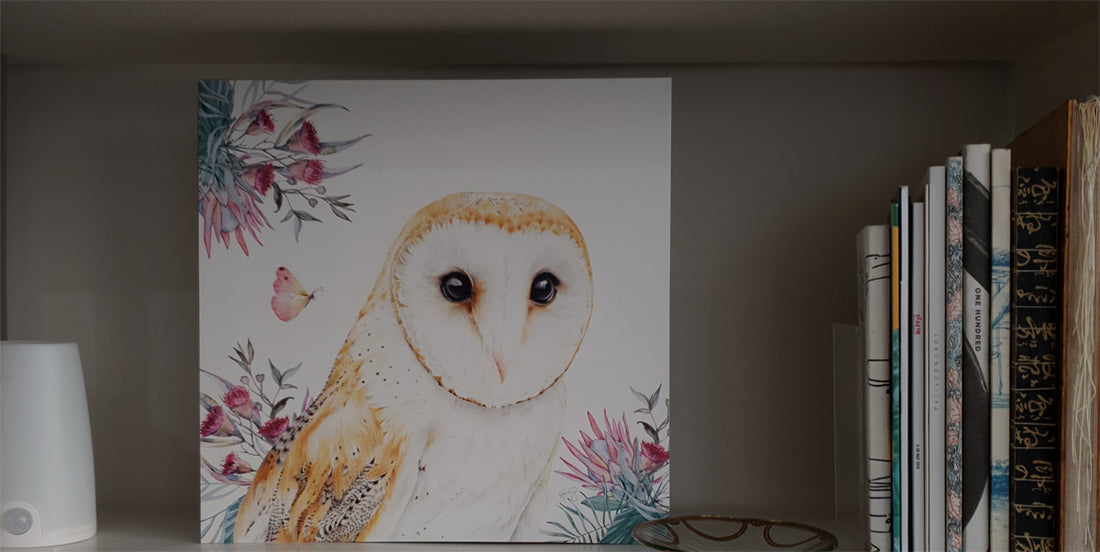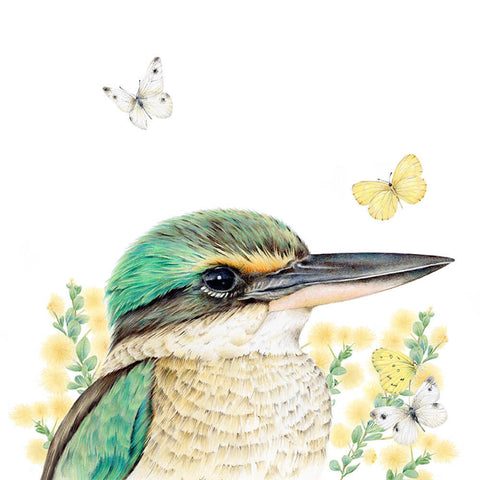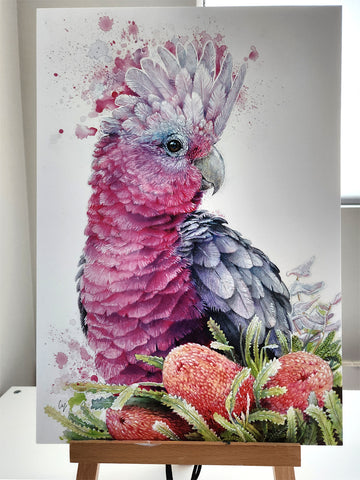
Australian bird art + prints | perfect for any space
Australian Bird art prints are a beautiful and unique way to bring a touch of nature into your home. These prints capture the quirkiness, fragility and majesty of the country's birdlife. Whether you're a nature enthusiast, bird lover, or simply looking for ways to lift your space, these prints are sure to make a statement. Let's explore the world of Australian bird art prints and discover the beauty of these feathered friends.
The wonder of birds
 |
 |
Introducing Yindi the Sacred Kingfisher. This art print would be a beautiful addition to any space and a timely reminder about protecting Australia's birds and their natural habitats. Printed on paper that is made from reclaimed coffee cup fibres, this print ticks all the eco-friendly boxes.
Native to Australia and islands between New Zealand and Indonesia, the Sacred Kingfisher mainly lives a solitary life in woodlands, mangroves, forests, and city parkland. With gorgeous turquoise, cream, and orange plumage, this artwork reminds us that clever colour combinations are found everywhere in nature.
While this kingfisher often feeds on large insects and small reptiles, the sight of one plunging into water to snap up a crustacean or small fish, is the perfect embodiment of grace and precision.
Also a kingfisher, and a much better known one, the Kookaburra is native to eastern Australia. Its unmistakable laughter immediately transports us to the heart of the bush, even when we live in the city and encounter them nesting nearby. The Kookaburra mates for life and both parents take care of the young.
For a collection of wall art, you can't go past these three cockatoos. They are beautiful originals (linocut prints) and you could start with one bird and build it up from there. But don't wait too long.

Check out our collection of feathered friends.
Ten superstars of the bird world
The kookaburra and kingfisher rightfully capture our attention, but Australia is a treasure trove of avian wonders that deserve admiration. Here is a selection of intriguing and captivating Australian birds:
- The nocturnal Tawny Frogmouth surprises its prey by swooping and scooping up insects, worms, snails, reptiles, frogs, even small mammals and birds, in its large, broad beak. During the day, this master of disguise melts into tree bark and the branches where it perches. The Tawny Frogmough is often mistaken for an owl, but it is a completely different species.
- Bowerbirds are great examples of birds adapting to the environment. The males construct beautiful bowers using flowers, blue parrot feathers, and snail shells in the wild, but bottle tops, glass, straws, clothes pegs, and tiny toys are used to great advantage in areas dominated by people. The sleek, midnight blue Satin Bowerbird is a master of this art.
- Found in large numbers in the north, the Brolga is a large waterbird that's losing ground in the south thanks to agriculture and land reclamation taking over its traditional habitat. This large grey crane, with a featherless red head and grey crown, is best known for its spectacular dance.
- The Emu is the most common flightless bird in Australia, but the fruit-eating Cassowary is bigger, heavier, and much more mysterious. Predominantly black, with a grey helmet and splashes of colour on the neck and head, the Southern Cassowary is found in north Queensland and New Guinea. This ancient bird, which is the largest in Australia, will attack if under threat, and has the claws to defend itself.
- With its name adapted from the Yuwaalaraay word “gilaa”, the Galah (not to be confused with the threatened Major Mitchell’s pink cockatoo) is Australia's most widespread cockatoo. Distinctive pink plumage and playful behaviour make them a favourite in suburban neighbourhoods. The mid-air displays and lively chatter of a few birds is always delightful, though the noise can be deafening when they are in large flocks.
- The deceptively inconspicuous Red-eared Firetail from Western Australia quietly blends into its surroundings while foraging on the ground. But when it takes flight, it's a showy little thing with a bright-red rump, a bright-red ear spot, and a black-and-white spotted belly.
- Australia's only native bee-eater, the Rainbow Bee-eater can spot a flying insect from 50 metres. They live in the southern Australian outback (and are a favourite around Uluru) but migrate north during the winter. With plumage that ranges from red to violet, they are like little rainbows darting around in the sky.
- Another native bird living in southern and eastern Australia, the dainty Superb Fairywren, is found in many backyards. They live in groups but would be hard to spot if it weren't for the male's electric blue plumage. Once you see them, it is not hard to become engrossed in their intricate social lives.
- We see them here, we see them there, sometimes we're lucky and see them everywhere. And the Willie Wagtail delights every time. Flitting around with its little tail aloft, the Willie Wagtail is a forager so is often seen on the ground. They weave together their nests using soft grasses and plant material, held together with spider webbing. How cool is that!
- From August to November every year, citizens of Melbourne and beyond are enthralled by the lives of a pair of Peregrine Falcons nesting on a high-rise ledge at 367 Collins Street in the heart of the city. These fast and ferocious hunters are not native to Australia but deserve a place on this list for their adaptability and ability to enthral people (via YouTube) for months on end as the nesting pair nurtures, teaches, and then says farewell to the young.
Whether it's the kingfisher's grace, the kookaburra's call, or the overall quirkiness that appeals, Australia’s birdlife is a wonderful reminder of the extraordinary place we call home. So, next time you need to connect with the amazing world around us, think about adding a few new art prints to your walls.
-----------
From the top
- Barnyard Owl art print by Sarah Hardy
- Yindi the Sacred Kingfisher art print by Sarah Hardy
- Kookaburra's Garden art print by Sarah Hardy
- Three Cockatoos original linocut prints by Nicole Spillane
- Pink Galah art print Carlie Edwards
- Red-eared Firetail art print by Melanie Hava




![[ Instagram O Gosh ]](http://ogosh.shop/cdn/shop/collections/CAR-WCD-001-1.jpg?v=1723709601&width=1500)